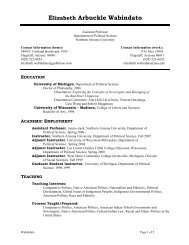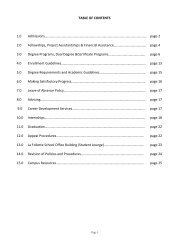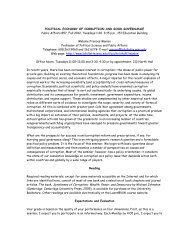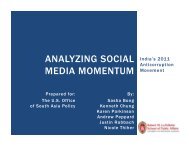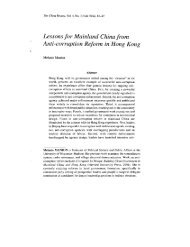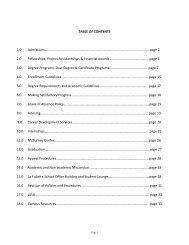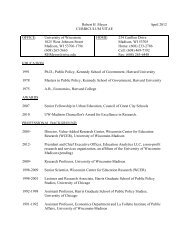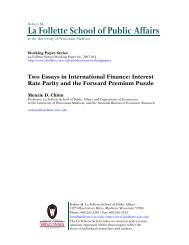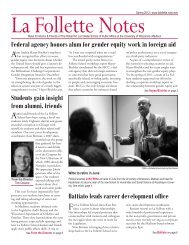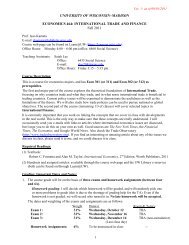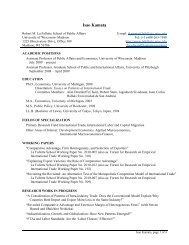POLITICAL POWER IN CONTEMPORARY CHINA Political Science ...
POLITICAL POWER IN CONTEMPORARY CHINA Political Science ...
POLITICAL POWER IN CONTEMPORARY CHINA Political Science ...
Create successful ePaper yourself
Turn your PDF publications into a flip-book with our unique Google optimized e-Paper software.
<strong>POLITICAL</strong> <strong>POWER</strong> <strong>IN</strong> <strong>CONTEMPORARY</strong> CH<strong>IN</strong>A<strong>Political</strong> <strong>Science</strong> 642, Fall 2007Mondays and Wednesdays, 8:00–9:15 a.m., B231 Van Vleck BuildingMelanie Frances ManionProfessor of <strong>Political</strong> <strong>Science</strong> and Public AffairsWebsite: http://www.lafollette.wisc.edu/facstaff/manionTelephone: 608.263.9060 or 262.6278 E‐mail: manion@lafollette.wisc.eduOffice hours: Wednesdays, 9:30–11:30 a.m., 201 Observatory Hill Office BuildingIn an era of reform that began about a quarter‐century ago, the People’s Republic of China has pursueda unique course of development to achieve an extraordinary rate of sustained rapid economic growth. Itis now the world’s biggest holder of foreign exchange reserves, second biggest economy in purchasingpower parity terms, and third biggest recipient of foreign direct investment. The domestic politics thatproduced this economic revolution exhibit no comparable liberalization, however: mainland Chinaremains essentially a party‐state, where a single communist party effectively monopolizes organizedpolitical power. Evidence of the economic revolution overwhelms at a glance. By contrast, to gauge thescope and implications of the significant, but distinctly more modest and ambivalent, political changerequires a more powerful analytic lens. This is the main goal of this undergraduate lecture course.The course begins with an introduction to the historical context, one standard by which to assesschange. An examination of politics at the center of power follows. Most of the course considers Chinesepolitics beyond Beijing, across a range of topics organized around two themes. The first theme ismanaged representation, which refers to new initiatives and responses to new demands from society.The second theme is major policy challenges, many of which are byproducts of economic reform policiesand rapid economic growth. How well China manages new pressures for representation and confrontsmajor policy challenges in the coming decades will have major consequences for mainland China and farbeyond its borders.Required reading materials are contained in the four books listed below and in a course reader. Thebooks are available for purchase at the University Bookstore and are also on reserve at the CollegeLibrary. The course reader is available for purchase at the Social <strong>Science</strong> Copy Center at 6120 Social<strong>Science</strong> Building and is also accessible through College Library Electronic Reserves.GGGGElizabeth C. Economy, The River Runs Black: The Environmental Challenge to China’s Future(Ithaca, N.Y.: Cornell University Press, 2004).Peter Hays Gries and Stanley Rosen, eds., State and Society in 21st‐Century China: Crisis,Contention, and Legitimation (New York: RoutledgeCurzon, 2004).Lionel M. Jensen and Timothy B. Weston, eds., China’s Transformations: The Stories beyond theHeadlines (Lanham, Md.: Rowman and Littlefield, 2007).Kenneth Lieberthal, Governing China: From Revolution through Reform, 2nd edition (New York:Norton, 2004).Your course grade is the sum of your performance on: (1) an in‐class examination on 24 October, (2) acumulative final examination on 17 December, and (3) a research‐based analytical paper—a hard copy of
<strong>Political</strong> Power in Contemporary China, Fall 2007, page 2which is due in class on 21 November. The midterm examination and paper each account for 30 percentof your course grade. The final examination accounts for 40 percent of your course grade. Details aboutthe paper are provided on the final page of this syllabus. Both examinations on the dates and timesnoted in the schedule are required components of this course. Do not make arrangements that conflictwith them. If you are unable to fulfill these requirements, be prepared to accept a course grade thatreflects incomplete fulfillment of requirements. In addition, the due date and time for the paper is astrict deadline: I will gladly accept a paper submitted early, but I will lower grades for late papers. Anelectronic submission does not substitute for a hard copy.On my web page you will find links to electronic resources to consult in research for your analyticalpaper, to augment your basic knowledge of current events related to China, or to sate (or stimulate)your broader intellectual curiosity about contemporary China.If you are registered in this course, each Sunday you will receive by e‐mail attachment the PowerPointslides that accompany the lectures scheduled for the week ahead.5 SeptemberIntroductionG Lieberthal, Governing China, chapters 1–3.For further reading:SCHEDULEGGGGLucien Bianco, Origins of the Chinese Revolution, 1915–1949 (Stanford, Cal.: Stanford UniversityPress, 1971).Tony Saich, ed., The Rise to Power of the Chinese Communist Party (Armonk, N.Y.: M. E. Sharpe,1996).Chalmers A. Johnson, Peasant Nationalism and Communist Power: The Emergence ofRevolutionary China (Stanford, Cal.: Stanford University Press, 1962).Jonathan D. Spence, Gate of Heavenly Peace: The Chinese and Their Revolution, 1895–1980 (NewYork: Viking Press, 1981).HISTORICAL CONTEXT AS PROLOGUELittle remains of Mao’s grand revolutionary schemes. Yet, without a grasp of this political historyit is impossible to appreciate the crucial context of the past quarter‐century: what has beenrejected.10 SeptemberPolicy Oscillations: An Overview of Post‐1949 <strong>Political</strong> EconomyG Lieberthal, Governing China, chapters 4 and 5.GFor further reading:Barry Naughton, The Chinese Economy: Transitions and Growth (Cambridge, Mass.: MIT Press,
<strong>Political</strong> Power in Contemporary China, Fall 2007, page 32007).12 SeptemberCase Study: Great Leap Forward, 1958–61GCourse reader and e‐reserves: Jasper Becker, Hungry Ghosts: Mao’s Secret Famine (New York:Free Press, 1996), chapters 5 and 6.For further reading:GGGGGRobert Ash, “Squeezing the Peasants: Grain Extraction, Food Consumption and Rural LivingStandards in Mao’s China,” China Quarterly, no. 188 (2006): 959–998.David M. Bachman, Bureaucracy, Economy, and Leadership in China: The Institutional Origins ofthe Great Leap Forward (Cambridge: Cambridge University Press, 1991).Thomas P. Bernstein, “Mao Zedong and the Famine of 1959–1960: A Study in Wilfulness,” ChinaQuarterly, no. 186 (2006): 421–445.Roderick MacFarquhar, The Origins of the Cultural Revolution, vol. 2, The Great Leap Forward,1958–1960 (New York: Columbia University Press, 1983).Dali L. Yang, Calamity and Reform in China: State, Rural Society, and Institutional Change sincethe Great Leap Forward (Stanford, Cal.: Stanford University Press, 1996).17 SeptemberCase Study: Cultural Revolution, 1966–69GCourse reader and e‐reserves: Jung Chang, Wild Swans: Three Daughters of China (New York:Anchor Books, 1991), chapters 14–17.For further reading:GGJoseph W. Esherick, Paul G. Pickowicz, and Andrew Walder, eds., The Chinese Cultural Revolutionas History (Stanford, Cal.: Stanford University Press).Andrew G. Walder and Yang Su, “The Cultural Revolution in the Countryside: Scope, Timing andHuman Impact,” China Quarterly, no. 173 (2003): 74–99.19 SeptemberWhat Is Socialist about China after 1978?GGGBruce J. Dickson, “Dilemmas of Party Adaptation: The CCP’s Strategies for Survival,” chapter 7 inGries and Rosen, State and Society in 21st‐Century China.Stanley Rosen, “The State of Youth/Youth and the State in Early 21st‐Century China: TheTriumph of the Urban Rich?” chapter 8 in Gries and Rosen, State and Society in 21st‐CenturyChina.Peter Hays Gries, “Popular Nationalism and State Legitimation in China,” chapter 9 in Gries andRosen, State and Society in 21st‐Century China.POLITICS AT THE CENTER OF <strong>POWER</strong>
<strong>Political</strong> Power in Contemporary China, Fall 2007, page 4Mainland China has abandoned the strictures of communist ideology, but it retains much of theessential structure of the Leninist communist party‐state, reinterpreted and reinvigorated in thepost‐Mao era. Indeed, despite major policy challenges, political reforms have probablystrengthened the party‐state.24 SeptemberStructures of GovernanceG Lieberthal, Governing China, chapter 6.For further reading:GGGGSusan Shirk, The <strong>Political</strong> Logic of Economic Reform in China, 55–128 (Berkeley: University ofCalifornia Press, 1993).Murray Scot Tanner, The Politics of Lawmaking in Post‐Mao China: Institutions, Processes, andDemocratic Prospects, 51–132 (Oxford: Oxford University Press, 1999).Kevin J. O’Brien, Reform without Liberalization: China’s National People’s Congress and thePolitics of Institutional Change (Cambridge: Cambridge University Press, 1990).Jae Ho Chung, “Reappraising Central‐Local Relations in Deng’s China: Decentralization, Dilemmasof Control, and Diluted Effects of Reform,” in Chien‐min Chao and Bruce J. Dickson, eds.,Remaking the Chinese State: Strategies, Society, and Security, 46–75 (New York: Routledge,2001).26 SeptemberRelationships of AuthorityG Lieberthal, Governing China, chapter 7.For further reading:G Carol Lee Hamrin, “The Party Leadership System,” in Kenneth G. Lieberthal and David M.Lampton, eds., Bureaucracy, Politics, and Decision Making in Post‐Mao China, 95–124 (Berkeley:University of California Press, 1992).G Kjeld Erik Brǿdsgaard, “Management of Party Cadres in China,” in Kjeld Erik Brǿdsgaard andYongnian Zheng, eds., Bringing the Party Back In: How China Is Governed, 57–91 (Singapore: EastAsian Institute, National University of Singapore, 2004).G David Shambaugh, Modernizing China’s Military: Progress, Problems, and Prospects (Berkeley:University of California Press, 2002).G Maria Edin, “Remaking the Communist Party‐State: The Cadre Responsibility System at the LocalLevel in China,” China: An International Journal, vol. 1, no. 1: 1–15.1 October<strong>Political</strong> Elites and Elite PoliticsGCourse reader and e‐reserves: Cheng Li, China’s Leaders: The New Generation (Lanham, Md.:Rowman and Littlefield, 2001), chapter 6.
<strong>Political</strong> Power in Contemporary China, Fall 2007, page 5GCourse reader and e‐reserves: Zhiyue Bo, China’s Elite Politics: <strong>Political</strong> Transition and PowerBalancing (Singapore: World Scientific, 2007), conclusion.For further reading:G Richard Daniel Ewing, “Hu Jintao: The Making of a Chinese General Secretary,” China Quarterly,no. 173 (2002): 17–34.G Zhiyue Bo, “The 16th Central Committee of the Chinese Communist Party: Formal Institutionsand Factional Groups,” Journal of Contemporary China, vol. 13, no. 39 (2004): 223–256.G Li Cheng, “Jiang Zemin’s Successors: The Rise of the Fourth Generation of Leaders in the PRC,”China Quarterly, no. 161 (2000): 1–40.G Joseph Fewsmith, Elite Politics in Contemporary China (Armonk, N.Y.: M. E. Sharpe, 2001).3 OctoberPolicy ProcessesGCourse reader and e‐reserves: Murray Scot Tanner, “How a Bill Becomes a Law in China: Stagesand Processes in Lawmaking,” China Quarterly, no. 141 (1995): 39–64.For further reading:G Scott Kennedy, The Business of Lobbying in China (Cambridge, Mass.: Harvard University Press,2005).G Special Issue: “China’s Think Tanks,” China Quarterly, no. 171 (2002).G Lu Ning, The Dynamics of Foreign‐Policy Decisionmaking in China, 2nd edition (Boulder, Colo.:Westview Press, 2000).G Carol Lee Hamrin and Suisheng Zhao, eds., Decision‐Making in Deng’s China: Perspectives fromInsiders (Armonk, N.Y.: M. E. Sharpe, 1995).MANAGED REPRESENTATIONThe current official mantra is to maintain “order and stability” and promote a “harmonious andwell‐off society.” This will require strategic management of groups in society that seekrepresentation of their interests in policy outcomes.8 OctoberA New <strong>Political</strong> EconomyG Lieberthal, Governing China, chapter 8.For further reading:GGGNicholas R. Lardy, Integrating China into the Global Economy (Washington, D.C.: BrookingsInstitution, 2002).Christine Wong, ed., Financing Local Government in the People’s Republic of China (Oxford:Oxford University Press, 1997).David Zweig, Internationalizing China: Domestic Interests and Global Linkages (Ithaca, N.Y.:
<strong>Political</strong> Power in Contemporary China, Fall 2007, page 6GGGGCornell University Press, 2002).Yasheng Huang, Selling China: Foreign Direct Investment during the Reform Era (Cambridge:Cambridge University Press, 2003.Jean C. Oi, Rural China Takes Off: Institutional Foundations of Economic Reform (Berkeley:University of California Press, 1999).Andrew H. Wedeman, From Mao to Market: Rent Seeking, Local Protectionism, andMarketization in China (Cambridge: Cambridge University Press, 2003).Carsten A. Holz, “’Fast, Clear and Accurate’: How Reliable Are Chinese Output and EconomicGrowth Statistics?” China Quarterly, no. 173 (2003): 122–163.10 OctoberLocal Congress Elections and Local CongressesGGCourse reader and e‐reserves: Kevin O’Brien, “Agents and Remonstrators: Role Accumulation byChinese People’s Congress Deputies,” China Quarterly, no. 138 (1994): 359–380.Course reader and e‐reserves: Lianjiang Li, “Direct Township Elections,” in Elizabeth J. Perry andMerle Goldman, eds., Grassroots <strong>Political</strong> Reform in Contemporary China (Cambridge, Mass.:Harvard University Press, 2007), chapter 5.For further reading:G Yong Nam Cho, “From ‘Rubber Stamps’ to ‘Iron Stamps’: The Emergence of Chinese LocalPeople’s Congresses as Supervisory Powerhouses,” China Quarterly, no. 171 (2002): 724–740.G Dong Lisheng, “Direct Township Elections in China: Latest Developments and Prospects,” Journalof Contemporary China, vol. 15, no. 48 (2006): 503–516.G Tianjian Shi, <strong>Political</strong> Participation in Beijing (Cambridge, Mass.: Harvard University Press, 1997).G Andrew J. Nathan, Chinese Democracy (Berkeley: University of California Press, 1985).15 OctoberVillage Elections and Village CommitteesGGCourse reader and e‐reserves: Kevin O’Brien and Lianjiang Li, “Accommodating ‘Democracy’ in aOne‐Party State: Introducing Village Elections in China,” China Quarterly, no. 162 (2000): 465–489.Course reader and e‐reserves: Lianjiang Li, “The Empowering Effect of Village Elections in China,”Asian Survey, vol. 43, no. 4 (2003): 648–662.For further reading:G Daniel Kelliher, “The Chinese Debate over Village Self‐Government,” China Journal, no. 37(1997): 63–86.G Guo Zhenglin and Thomas P. Bernstein, “The Impact of Elections on the Village Structure ofPower: The Relations between the Village Committees and the Party Branches,” Journal ofContemporary China, vol. 13, no. 39 (2004): 257–275.G John James Kennedy, “The Face of ‘Grassroots Democracy’ in Rural China: Real versus Cosmetic
<strong>Political</strong> Power in Contemporary China, Fall 2007, page 7Elections,” Asian Survey, vol. 42, no. 3 (2002): 456–482.G Jean C. Oi and Scott Rozelle, “Elections and Power: The Locus of Decision‐Making in ChineseVillages,” China Quarterly, no. 162 (2000): 513–539.G Melanie Manion, “The Electoral Connection in the Chinese Countryside,” American <strong>Political</strong><strong>Science</strong> Review, vol. 90, no. 4 (1996): 736–748.G Melanie Manion, “Democracy, Community, Trust: The Impact of Chinese Village Elections inContext,” Comparative <strong>Political</strong> Studies, vol. 39, no. 3 (2006): 301–324.G Tianjian Shi, “Village Committee Elections in China: Institutionalist Tactics for Democracy,” WorldPolitics, vol. 51, no. 3 (1999): 385–412.G Lianjiang Li, “Elections and Popular Resistance in Rural China,” China Information, vol. 16, no. 1(2002): 89–107.17 OctoberSocial Organizations, NGOs, and GONGOsG Economy, The River Runs Black, chapters 1 and 5.G Course reader and e‐reserves: Tony Saich, “Negotiating the State: The Development of SocialOrganizations in China,” in Lowell Dittmer and Guoli Liu, eds., China’s Deep Reform: DomesticPolitics in Transition (Lanham, Md.: Rowman and Littlefield, 2006), chapter 10.For further reading:GGGGFayong Shi and Yongshun Cai, “Disaggregating the State: Networks and Collective Action inShanghai,” China Quarterly, no. 186 (2006): 314–332.Gordon White, Jude Howell, and Shang Xiaoyuan, In Search of Civil Society: Market Reform andSocial Change in Contemporary China (Oxford: Clarendon Press, 1996).Timothy Brook and B. Michael Frolic, eds., Civil Society in China (Armonk, N.Y.: M. E. Sharpe,1997).Jonathan Unger, “’Bridges’: Private Business, the Chinese Government and the Rise of NewAssociations,” China Quarterly, no. 147 (1996): 795–819.22 OctoberWorkers and CapitalistsGTimothy B. Weston, “Fueling China’s Capitalist Transformation: The Human Cost,” chapter 3 inJensen and Weston, China’s Transformations.For further reading:GGGMary Elizabeth Gallagher, Contagious Capitalism: Globalization and the Politics of Labor in China(Princeton, N.J.: Princeton University Press, 2005).Yasheng Huang, Selling China: Foreign Direct Investment during the Reform Era (Cambridge:Cambridge University Press, 2003).Margaret M. Pearson, China’s New Business Elite: The <strong>Political</strong> Consequences of EconomicReform (Berkeley: University of California Press, 1997).24 October
<strong>Political</strong> Power in Contemporary China, Fall 2007, page 8<strong>IN</strong>‐CLASS MIDTERM EXAM<strong>IN</strong>ATION29 OctoberOrganized ReligionsGCourse reader and e‐reserves: Beatrice Leung, “China’s Religious Freedom Policy: The Art ofManaging Religious Activity,” China Quarterly, no. 184 (2005): 894–913.For further reading:G Richard Madsen, China’s Catholics: Tragedy and Hope in an Emerging Civil Society (Berkeley:University of California Press, 1998).G Special Issue: “Religion in China Today,” China Quarterly, no. 174 (2003).G Xiao‐Qing Wang, “How Has a Chinese Village Remained Catholic? Catholicism and Local Culturein a Northern Chinese Village,” Journal of Contemporary China, vol. 15, no. 49 (2006): 687–704.31 OctoberNew Spiritual MovementsGDavid Ownby, “Qigong, Falun Gong, and the Body Politic in Contemporary China,” chapter 4 inJensen and Weston, China’s Transformations.For further reading:GGGJames Tong, “An Organizational Analysis of the Falun Gong: Structure, Communications,Financing,” China Quarterly, no. 171 (2002): 636–660.Cheris Shun‐ching Chan, “The Falun Gong in China: A Sociological Perspective,” China Quarterly,no. 179 (2004): 665–683.Ronald C. Keith and Zhiqiu Lin, “The ‘Falun Gong Problem’: Politics and the Struggle for the Ruleof Law in China,” China Quarterly, no. 175 (2003): 623–642.5 NovemberMinority NationalitiesGCourse reader and e‐reserves: Dru C. Gladney, “Islam in China: Accommodation or Separatism?”China Quarterly, no. 174 (2003): 451–467.For further reading:G S. Frederick Starr, ed., Xinjiang: China’s Muslim Borderland (Armonk, N.Y.: M. E. Sharpe, 2004).G Michael Dillon, Xinjiang: China’s Muslim Far Northwest (London: RoutledgeCurzon, 2003).G Brantly Womack, “Resolving Asymmetric Stalemate: The Case of the Tibet Question,” Journal ofContemporary China, vol. 16, no. 52 (2007): 443–460.G Tsering Shaka, The Dragon in the Land of Snows: A History of Modern Tibet since 1947 (London:Pimlico, 1999).G Tom Grunfeld, The Making of Modern Tibet, revised edition (Armonk, N.Y.: M. E. Sharpe, 1996).
<strong>Political</strong> Power in Contemporary China, Fall 2007, page 9GGGGNimrod Baranovitch, “From the Margins to the Centre: The Uyghur Challenge in Beijing,” ChinaQuarterly, no. 175 (2003): 726–750.Benjamin Penny, “The Life and Times of Li Hongzhi: Falun Gong and Religious Biography,” ChinaQuarterly, no. 175 (2003): 643–661.Katherine Palmer Kaup, “Regionalism versus Ethnicnationalism in the People’s Republic ofChina,” China Quarterly, no. 172 (2002):863–884.Melvyn C. Goldstein, The Snow Lion and the Dragon: China, Tibet, and the Dalai Lama (Berkeley:University of California Press, 1997).MAJOR POLICY CHALLENGESMeeting with President George W. Bush in late 2005, Chinese President Hu Jintao acknowledgedthat problems of corruption, unrest, inequality, and pollution consume nearly all his time.7 NovemberPopulation PlanningGuest Lecturer: M. Giovanna Merli, Associate Professor of Sociology, Wisconsin–MadisonGGCourse reader and e‐reserves: Tyrene White, “Domination, Resistance and Accommodation inChina’s One‐Child Campaign,” in Elizabeth J. Perry and Mark Seldon, eds., Chinese Society:Change, Conflict and Resistance, 2nd ed. (London: Routledge, 2003), chapter 8.Course reader and e‐reserves: M. Giovanna Merli, Zhenchao Qian, and Herbert L. Smith,“Adaptation of a <strong>Political</strong> Bureaucracy to Economic and Institutional Change under Socialism:The Chinese State Family Planning System,” Politics and Society, vol. 32, no. 2 (2004): 231–256.For further reading:G Tyrene White, China’s Longest Campaign: Birth Planning in the People’s Republic, 1949–2005(Ithaca, N.Y.: Cornell University Press, 2006.12 NovemberEconomic InequalityG Lieberthal, Governing China, chapter 10.G Dorothy J. Solinger, “The New Crowd of the Dispossessed: The Shift of the Urban Proletariatfrom Master to Mendicant,” chapter 2 in Gries and Rosen, State and Society in 21st‐CenturyChina.For further reading:GGDorothy Solinger, Contesting Citizenship in Urban China: Peasant Migrants, the State, and theLogic of the Market (Berkeley: University of California Press, 1999).C. W. Kenneth Keng, “China’s Unbalanced Economic Growth, “Journal of Contemporary China,vol. 15, no. 46 (2006): 183–214.14 and 19 NovemberRural Unrest and Urban Protests
<strong>Political</strong> Power in Contemporary China, Fall 2007, page 10G Course reader and e‐reserves: Kevin J. O’Brien and Lianjiang Li, Rightful Resistance in Rural China(Cambridge: Cambridge University Press, 2006), chapter 2.G Teresa Wright, “Contesting State Legitimacy in the 1990s: The China Democracy Party and theChina Labor Bulletin,” chapter 6 in Gries and Rosen, State and Society in 21st‐Century China.G Course reader and e‐reserves: Melanie Manion, “Reluctant Duelists: The Logic of the 1989Protests and Massacre,” in Michel Oksenberg, Lawrence R. Sullivan, and Marc Lambert, eds.,Beijing Spring, 199: Confrontation and Conflict: The Basic Documents (Armonk, N.Y.: M. E.Sharpe, 1990).G Course reader and e‐reserves: Murray Scot Tanner, “Rethinking Law Enforcement and Society:Changing Policy Analyses of Social Unrest,” in Neil J. Diamant, Stanley B. Lubman, and Kevin J.O’Brien, eds., Engaging the Law in China: State, Society, and Possibilities for Justice (Stanford:Stanford University Press, 2005), chapter 8.For further reading:GGGGGGThomas P. Bernstein and Xiaobo Lu, Taxation Without Representation in Contemporary RuralChina (Cambridge: Cambridge University Press, 2003).Jae Ho Chung, Hongyi Lai, and Ming Xia, “Mounting Challenges to Governance in China:Surveying Collective Protestors, Religious Sects and Criminal Organizations,” China Journal, no.56 (2006): 1–32.Teresa Wright, “The China Democracy Party and the Politics of Protest in the 1980s–1990s,”China Quarterly, no. 172 (2002): 906–926.John W. Lewis and Xue Litai, “Social Change and <strong>Political</strong> Reform in China: Meeting theChallenge of Success, China Quarterly, no. 176 (2003): 926–942.Yongshun Cai, “Collective Ownership or Cadres’ Ownership? The Non‐agricultural Use ofFarmland in China,” China Quarterly, no. 175 (2003): 662–680.Samuel P. S. Ho and George C. S. Lin, “Emerging Land Markets in Rural and Urban China:Policies and Practices,” China Quarterly, no. 175 (2003): 681–707.21 NovemberDocumentary: “The Courtrooms and Law Schools of China”HARD COPY OF PAPER DUE <strong>IN</strong> CLASS26 NovemberLaw and Legal InstitutionsGCourse reader and e‐reserves: Randall Peerenboom, China’s Long March toward Rule of Law(Cambridge: Cambridge University Press, 2002), chapter 4.For further reading:GGStanley B. Lubman, Bird in a Cage: Legal Reform in China after Mao (Stanford, Cal.: StanfordUniversity Press, 1999).Neil J. Diamant, Stanley B. Lubman, and Kevin J. O’Brien, Engaging the Law in China: State,Society, and Possibilities for Justice (Stanford, Cal.: Stanford University Press, 2005).
<strong>Political</strong> Power in Contemporary China, Fall 2007, page 1128 NovemberCorruption and Anticorruption ReformGGCourse reader and e‐reserves: Melanie Manion, Corruption by Design: Building CleanGovernment in Mainland China and Hong Kong (Cambridge, Mass.: Harvard University Press,2004), chapter 3.Course reader and e‐reserves: Melanie Manion, “Lessons for Mainland China fromAnticorruption Reform in Hong Kong,” China Review, vol. 4, no. 2 (2004): 81–97.For further reading:G Andrew Wedeman, “Anticorruption Campaigns and the Intensification of Corruption in China,”Journal of Contemporary China, vol. 14, no. 42 (2005): 93–116.G Andrew Wedeman, “The Intensification of Corruption in China,” China Quarterly, no. 180(2004): 895–921.G Shawn Shieh, “The Rise of Collective Corruption in China: The Xiamen Smuggling Case,” Journalof Contemporary China, vol. 14, no. 42 (2005): 67–92.G Elizabeth A. Quade, “The Logic of Anticorruption Enforcement Campaigns in ContemporaryChina,” Journal of Contemporary China, vol. 16, no. 50 (2007): 65–77.3 DecemberEnvironmental DegradationG Economy, The River Runs Black, chapters 3, 4, and 6.G Judith Shapiro, “The <strong>Political</strong> Roots of China’s Environmental Degradation,” chapter 2 in Jensenand Weston, China’s Transformations.For further reading:G Kirsten A. Day, ed., China’s Environment and the Challenge of Sustainable Development (Armonk,N.Y.: M. E. Sharpe, 2005).G Phillip Stalley and Dongning Yang, ”An Emerging Environmental Movement in China?” ChinaQuarterly, no. 186 (2006); 333–356.G Special issue: “China’s Environment,” China Quarterly, no. 156 (1998).5 DecemberPublic Opinion, Mass Media, and the InternetGuest Lecturer: Yongming Zhou, Associate Professor of Anthropology, Wisconsin–MadisonGGXiao Qiang, “The Internet: A Force to Transform Chinese Society?” chapter 6 in Jensen andWeston, China’s Transformations.Tong Lam, “Herding the Masses: Public Opinion and Democracy in Today’s China,” chapter 10 inJensen and Weston, China’s Transformations.For further reading:
<strong>Political</strong> Power in Contemporary China, Fall 2007, page 12G Tamara Renee Shie, “The Tangled Web: Does the Internet Offer Promise or Peril for the ChineseCommunist Party?” Journal of Contemporary China, vol. 13, no. 40 (2004): 523–540.G Guobin Yang, “How Do Chinese Civic Associations Respond to the Internet? Findings from aSurvey,” China Quarterly, no. 189 (2007): 122–143.G Michael Chase and James Mulvenon, You’ve Got Dissent: Chinese Dissident Use of the Internetand Beijing’s Counter‐Strategies (Santa Monica, Cal.: RAND, 2002).G Xia Li Lollar, “Assessing China’s E‐Government: Information, Service, Transparency and CitizenOutreach of Government Websites,” Journal of Contemporary China, vol. 15, no. 46 (2006): 31–41.G Kevin Latham, “Nothing but the Truth: News Media, Power and Hegemony in South China,”China Quarterly, no. 163 (2000): 633–654.G Anne‐Marie Brady, “Guiding Hand: The Role of the Central Propaganda Department in theCurrent Era,” Westminster Papers in Communication and Culture, vol. 3, no. 1 (2006): 58–77.G David Shambaugh, “China’s Propaganda System: Institutions, Processes and Efficacy,” ChinaJournal, no. 57 (2007): 25–58.G Benjamin L. Liebman, “Watchdog or Demagogue? The Media in the Chinese Legal System,”Columbia Law Review, vol. 105, no. 1 (2005): 1–52.G Yuezhi Zhao, Media, Market, and Democracy in China: Between the Party Line and the BottomLine (Urbana: University of Illinois Press, 1998).G Stephanie Hemelryk Donald, Michael Keane, and Yin Hong, eds., Media in China: Consumption,Content and Crisis (London: RoutledgeCurzon, 2002).G Daniel C. Lynch, After the Propaganda State: Media, Politics, and “Thought Work” in ReformedChina (Stanford, Cal.: Stanford University Press, 1999).G Yuezhi Zhao and Sun Wusan, “Public Opinion Supervision: Possibilities and Limits of the Media inConstraining Local Officials,” in Elizabeth J. Perry and Merle Goldman, eds., Grassroots <strong>Political</strong>Reform in Contemporary China, 300–326 (Cambridge, Mass.: Harvard University Press, 2007).G Edward X. Gu, “The Economics Weekly, the Public Sphere and the Voices of Chinese IndependentIntellectuals,” China Quarterly, no. 147 (1996): 860–888.G Wenfang Tang, Public Opinion and <strong>Political</strong> Change in China, 79–100 (Stanford, Cal.: StanfordUniversity Press, 2005).G Daniel C. Lynch, “Dilemmas of ‘Thought Work’ in Fin‐de‐Siècle China,” China Quarterly, no. 157(1999): 173–201.10 DecemberRelations with TaiwanGCourse reader and e‐reserves: Susan L. Shirk, China: Fragile Superpower (Oxford: OxfordUniversity Press, 2007), chapter 7.12 DecemberRelations with the United StatesGGJonathan S. Noble, “Culture Matters—A Report from the Field of U.S.‐China Relations,” forewordto Jensen and Weston, China’s Transformations.Lionel M. Jensen and Timothy B. Weston, “The New China, a Different United States,”
<strong>Political</strong> Power in Contemporary China, Fall 2007, page 13GGintroduction to Jensen and Weston, China’s Transformations.Lionel M. Jensen, “China, the United States, and the Fragile Planet,” afterword to Jensen andWeston, China’s Transformations.Dingxin Zhao, “An Angle on Nationalism in China Today: Attitudes among Beijing Students afterBelgrade 1999,” China Quarterly, no. 172 (2002): 885–905.For further reading:G David Shambaugh, ed., Power Shift: China and Asia’s New Dynamics (Berkeley: University ofCalifornia Press, 2005).G Robert L. Suettinger, Beyond Tiananmen: The Politics of China’s U.S.–China Relations, 1989–2000 (Washington, D.C.: Brookings Institution, 2003).G Michael D. Swaine and Ashley J. Tellis, Interpreting China’s Grand Strategy: Past, Present, andFuture (Santa Monica, Cal.: RAND, 2000).17 DecemberF<strong>IN</strong>AL EXAM<strong>IN</strong>ATION AT 2:45 p.m.Location to be announcedResearch Paper Assignment: Policy MemoHard copy due in class on 21 NovemberLength guidelines: 2400–3000 words, which is about 8–10 pages. This does not includereferences. Your memo must be double‐spaced, your pages must be numbered, and you mustinclude a word count. I will read no more than 3000 words in a memo; I will randomly selectpages to read from memos that exceed 3000 words.Choose an issue of interest to you that mainland Chinese authorities are ignoring, mishandling,or addressing well. The range of possibilities is huge: capital flight, water pollution, urbanmigration, land expropriation, and food safety are a few examples. Research both the issue andhow Chinese authorities are meeting the challenges it presents. Your assignment is to produce awell‐researched analytical policy memo on the issue.Your grade will mainly reflect: (1) your demonstrated research effort, and (2) your success inpresenting and supporting a clear analytical argument with abundant specific evidence fromrelevant scholarly sources. Substantively excellent papers with significant problems of style willnot be awarded a grade in the A range, however.Substantive guidelinesYour paper should focus on points 1, 2, and 3 below. Point 4 can be addressed in a paragraph ortwo, and point 5 can be addressed in a few sentences.1. Clearly describe the problem. What is its distribution across localities and time? Who are itsvictims and beneficiaries? Is this a problem common to developing countries, authoritarianstates, economies in transition from central planning, Asian cultures? Is this sort of situation best
<strong>Political</strong> Power in Contemporary China, Fall 2007, page 14improved through government intervention or not? You may wish to consider other contexts inwhich this problem has arisen in answering these questions.2. Describe the current policy measures, if any, taken to address the problem. You may wish todescribe implementation of policy measures too.3. Analytically evaluate the status quo policy. To what degree is current policy successful inaddressing the problem? How are you measuring “success”? What features of current policy aremost responsible for its success or failure?4. Assuming no change in status quo policy, is the situation likely to worsen or improve in the nearfuture? What sort of time frame are you using to answer this question? What evidence supportsyour prediction?5. Recommend either “no policy change” or “policy change.” You are not required in this policymemo to propose content of new policy, but your evaluation of the status quo policy and futureprospects should lead logically to your recommendation of change or no change.Stylistic guidelinesGGGGUse appropriate subheadings in your memo, guided by the five features noted above: problem,status quo policy, evaluation of policy, future prospects, and recommendation.Use memo form; date, to, from, and re. The “re” heading of your memo should make very clearwhat policy problem you are addressing. Address your policy memo to an appropriate official,clearly indicating whether the official is a generalist or specialist, in a party or governmentagency, and at what level. For example, a memo might be addressed to: Bureau Chief,Environmental Protection Bureau, Shanghai Municipal Government. Alternatively, it might bemore appropriately addressed to a known leader at the center, such as Premier WEN Jiabao orParty General Secretary HU Jintao. It depends on the issue and how you define its scope.Refer to the Writer’s Handbook on the Writing Center website at www.wisc.edu/writing forguidelines on what is considered plagiarism, when to cite, citation style, et cetera.Consult scholarly sources for your evidence, do not rely significantly on journalistic sources, andbe advised that I do not consider Wikipedia a valid source for this assignment.If you would like advice about sources or the suitability of a topic, you are very welcome tovisit me in my office. See me earlier, rather than later.



